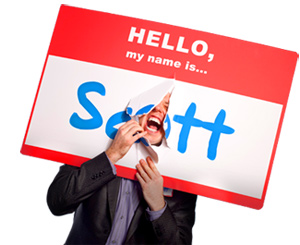If you walk into your local bookstore and pick up any random title on interpersonal communication, the majority of the books will simply remind you to “always be approachable.”
Wow, you think, thanks for the advice.
But when you walk into a room full of strangers, attend a national conference or start a new job, that advice doesn’t help maximize your approachability.
In the book The Power of Approachability, my goal was to help the reader change his or her paradigm of communication and think of every interaction – big or small, online or off – in terms of approachability.
Now, as the research continues, I’ve created a new model. It’s called The Approachability Indicator™. For the past five years, I’ve examined thousands of case studies, scientific journals, books, interviews, surveys and articles on what the world thinks approachability means. And although the research showed that various disciplines and people viewed the idea differently, there were several fascinating commonalities among all the sources.
This system will teach you what approachability is, why it’s critical to successful communication, and it will provide you with concrete techniques to MAXIMIZE it.
The Approachability Indicator™ is based on the following model:

To begin, the word ‘approachability’ derives from the Latin verb apropiare, which means ‘to come nearer to.’ Therefore, approachability is a two way street. And the model represents both inbound and outbound channels. Outbound, or proactive approachability, is stepping onto someone else’s front porch. It’s about being bold. It’s about breaking the silence. And it’s about taking initiative. Inbound, or reactive approachability, is welcoming others onto your front porch. It’s about openness. It’s about availability. And it’s about making yourself accessible to others.
As you see from Fig. 1, all types of approachability fall into one of seven categories. As you read the list below, each section will give you several techniques to help MAXIMIZE it!
Building Social Capital
Willingness to develop new relationships
1) Acknowledge people you know
2) Welcome new business/personal relationships with various types of people
3) Network for the purpose of mutually valuable relationships, not sales
4) Become easily engaged by friends and strangers alike
5) Maintain the confidence to talk to high level professionals
6) Learn to enjoy meeting new people
7) Constantly enlarge your network
8) Make eye contact, even if you don’t know someone
What You Say
Dynamics of conversation
1. Patiently allow others to interrupt you for conversational clarity
2. Leave a conversation making your partner feel good about himself
3. Make sure every person in the group is involved in the conversation
4. Allow people to finish jokes, even if you’re heard them a million times
5. Break the uncomfortable silence when nobody else will
6. Still be friendly to others, even if you’re in a bad mood
7. Change the subject when someone else feels uncomfortable
8. Be sensitive to other people’s communication apprehension
9. Give people an experience, not just a conversation
What You Don’t Say
Non-verbal behaviors
1. You have two ears and one mouth – listen and talk accordingly
2. Use gestures when you talk
3. Wear clothes that make you look and feel comfortable
4. Give high-fives and hugs when appropriate
5. Vary your vocal inflection when you talk
6. Look ahead when you’re walking, not at the ground
7. Smile when introduced to someone
8. Smile when you say goodbye to someone
9. Smile when you answer the phone
10. Keep your arms uncrossed, even if it’s cold
11. Use adequate pauses during conversation, instead of talking for the sake of talking
Keeping It Real
Authentic personality
1. Inspire others instead of impress them
2. Become the world’s expert on yourself
3. Show others that you enjoy what you do
4. Be confident enough to be humble
5. Put your personality into everything you do and say
6. Have fun at work every day
7. Quickly make new people feel like they’ve known you for years
8. Be known by many people at your work, organization or faith group
9. Admit when you’re wrong, don’t know, or when you’ve screwed up
10. Be someone whom others “could tell anything”
Drop Me A Line
Easily reached
1. Return phone calls and emails within 24 hours
2. Carry several business cards in your bag, car or wallet
3. Avoid Hotmail, AOL or Yahoo for business transactions
4. Maintain a simple, easy-to-type, easy-to-remember email
5. Check your email at least three times a day
6. Offer various methods of contact (email, phone, fax, in-person, etc.)
7. Read emails aloud before sending them
PHYSICAL Availability
Openness of personal space
1. Greet others, even if you’re not designated as a “greeter”
2. Stop what you’re doing to address someone who comes to you
3. Seek out the first timers at meetings and parties
4. Talk to people before and after meetings, events, programs
5. Go out of your way to sit with people you don’t know
6. Do things that “aren’t your job” if it makes others more comfortable
7. Share travel plans with people who might need to get a hold of you
8. Be accessible outside of group situations for people who are shy in front of others
PERSONAL Availability
Openness of mind and heart
1. Make every encounter with another person feel valued
2. Find the answers to questions you don’t know instead of “faking it”
3. Address both trivial and serious problems of people who come to you
4. Receive criticism without taking it personally
5. Give criticism without sounding harsh
6. Listen to other people’s viewpoints and ideas, even if you don’t agree with them
7. Maintain openness, even about uncomfortable topics
8. Keep other people’s secrets
9. Be a boss, friend, co-worker, colleague AND/OR subordinate
This model also revolves around five benefits of maximum approachability. These factors answer the question: Why is approachability so important?
The first is opportunity. With strangers, you never know whom you’ll meet. With acquaintances, friends or family, you never know what you’ll learn. And with people in general, you never know how it’ll reciprocate. But you never will know until you take that first step. In other words, ‘you can’t win if you don’t play,’ ‘to grab the fruit you must go out on a limb,’ ‘the turtle only makes progress when he sticks his neck out,’ and the like.
The second benefit is confidence. When people perceive you as approachable, they are confident they can bring their issues, ideas and true selves to you. And when you equip yourself with the techniques and tips for starting, maintaining and closing conversations, it will reassure your own ability to become and UNFORGETTABLE communicator.
The third benefit of approachability is permission. Because we live in a fast paced, fear based culture, we need to inform others that it’s ok to communicate. According to interpersonal communication textbooks, humans engage with each for five reasons: to inquire, to relate, to play, to help or to manage. Still, none of those motivators can be carried out without permission.
The next benefit is comfort, and it is absolutely essential to approachability. From remembering names to open body language to appropriate topics of discussion, comfort is king. And if you want to assure that co-workers, clients, friends, family – even strangers – can approach you AND be approached by you, they have to be comfortable. And so do you.
Lastly, there’s trust; and it’s the summation of opportunity, confidence, permission and comfort. Imagine you’ve got a flat tire in the middle of nowhere. Your cell phone has no service. You’re stuck! So, you walk into town seeking help. About an hour later you come across two houses on opposite sides of the road. One is dark, deserted and dilapidated. The other has its lights on and a family sitting out on the front porch.
Which house would you choose?
99% of the people I ask this question choose the second house because it exudes opportunity. They’re confident the family is friendly and they’re comfortable saying hello to them. Ultimately, the front porch gives them permission to step up and trust that the strangers be willing to help them out of a bind.
That’s approachability.
LET ME ASK YA THIS…
Who’s the most approachable person you know?

